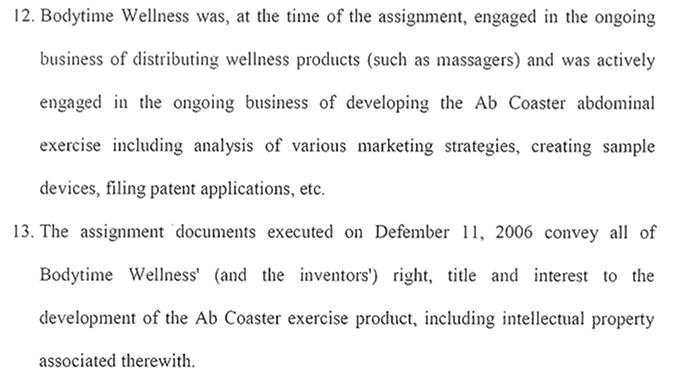I recently wrote about a case which held that, while there was an assignment of an invention, a continuation-in-part application was not assigned because it had new matter. I’m not sure if the outcome was right; at least I suspect that many drafters of assignment language haven’t thought about it that way.
The same decision also interpreted a section of the Lanham Act that general prohibits assignment of an intent-to-use application, an interpretation that I’m also not sure is consistent with the general understanding of this particular part of the statute. Let’s start with the law:
Section l0(a)(l) of the Lanham Act prohibits the assignment of intent-to-use trademark applications prior to the filing of a statement of use, unless a statutory exception is met:
|
(Brackets in original.)
In the case, Bodytime Wellness LLC filed an intent-to-use application for the mark AB COASTER for an exercise machine, then assigned the application to Tristar Products, Inc. before a statement of use was filed. A declaration by the now-owner of the trademark says that Bodytime was interested in distribution, but not manufacturing. Bodytime therefore transferred “all of its interest in the exercise device,” including the trademark and patent applications, to Tristar in exchange for a distribution license. Tristar then manufactured and marketed the device, with Bodytime personnel “actively contributing to the sale and continued development of the equipment bearing the AB COASTER mark.” The declaration continues:
If you can’t see the image, it says:
12. Bodytime Wellness was, at the time of the assignment, engaged in the ongoing business of distributing wellness products (such as massagers) and was actively engaged in the ongoing business of developing the Ab Coaster abdominal exercise including analysis of various marketing strategies, creating sample devices, filing patent applications, etc.
13. The assignment documents executed on December 11, 2006 [presumably the patent and trademark assignments] convey all of Bodytime Wellness’ (and the inventors’) right, title and interest to the development of the Ab Coaster exercise product, including intellectual property associated therewith.
I couldn’t find any transactional documents in the record except for the patent and trademark assignments.
Based on this record, the court found that the assignment from Bodytime to Tristar did not fit into the exception for assignment of an intent-to-use application in Section 10 of the Lanham Act, i.e., that it was not “an assignment to a successor to the business of the applicant, or portion thereof, to which the mark pertains, if that business is ongoing and existing.”
I have no quibble with the conclusion; the plaintiff tried to cobble together an assignment of an entire business when the only things that appears to have been assigned were a patent application and an intent-to-use trademark application. Personally I think the plaintiff introduced enough evidence to withstand summary judgment, but I don’t disagree that this is a reasonable conclusion based on the facts.
But I do quibble with the court’s statement of the law. The court quoted a non-precedential TTAB decision, Railrunner N.A., Inc. v. New Mexico Dept. of Transportation (blogged here by John Welch), for the proposition that a product must already exist before the application can be assigned:
| prior to the filing of an allegation of use, see Trademark Act §§ l(c)-(d), an intent-to-use (“ITU”) applicant may not transfer its application to another, unless it transfers with it at least that part of applicant’s business to which the mark pertains. And as the last clause of the quoted subsection [the exception] emphasizes, even that transfer is only permissible if the applicant actually has such a business, i.e., if the applicant is already providing the goods or services recited in the application. |
(Brackets in original; emphasis added.)
John Welch disagreed with the last part of the TTAB’s statement, as do I. There is no requirement in the statute that the particular product be available, only that the business to which the mark pertains have been acquired. For example, if one acquires an entire $100 billion pharmaceutical business, including drugs in development for which ITU applications have been filed but that are not yet sold, does that mean that the intent-to-use applications can’t be assigned? I don’t think so; that would mean that the applications could never become registered. The assigning owner wouldn’t be in a position to file a statement of use, since, having sold the business, it couldn’t begin use of the mark. This outcome is not what was intended with Section 10; Section 10 was meant to prevent trafficking in marks, not legitimate business transactions involving nascent product lines that happen to have pending intent-to-use applications.
But then the Ab Coaster court went even further, requiring that there be goodwill in the mark before it can be assigned and concluding, as one can only conclude, that there’s no goodwill in a mark that isn’t used yet. In other words, according to the Ab Coaster court, an intent-to-use application can’t be assigned unless the mark is in use.
The Ab Coaster court’s conclusion essentially eviscerates the statutory exception in Section 10. Note that Section 10 allows the assignment of an intent-to-use application after an amendment to allege use/declaration of use is filed whether or not the business is assigned (“A … mark for which an application to register has been filed shall be assignable with the good will of the business in which the mark is used…. Notwithstanding the preceding sentence, no application to register a mark under section 1051(b) of this title shall be assignable prior to the filing of an amendment [to allege use] under section 1051(c) of this title to bring the application into conformity with section 1051(a) of this title or the filing of the verified statement of use under section 1051(d) of this title…”, thus implicitly allowing assignment after the document alleging use has been filed). Therefore if a mark is in use, one simply has to file the amendment to allege use/statement of use before assigning it, an act that any trademark lawyer will advise that you do in order to avoid the very situation in this case. It is therefore exactly for those cases where one cannot allege use that the exception allowing the assignment of the application as part of an ongoing and existing business was intended.
Ab Coaster went too far, and further than necessary on the facts of the case, to find that the application was invalidly assigned. If it was relying on non-precedential administrative proceedings for its law, then it should have also considered Restifo v. Power Beverages, LLC, Opp. No. 91181671 (TTAB Sept. 21, 2011), which held that an assignment of an intent-to-use application by a company that only ever intended to license the mark to manufacturers was an assignment of the entire business. I suspect the court wanted to avoid having to reach a question of fact, i.e., whether there was a business assigned or just a patent application and trademark application, so it could dispose of the case on summary judgement. It is indeed a messy factual question, but it’s one that should be reached.
Ab Coaster Holdings, Inc. v. Greene, Nos. 2:10-CV-38, 2:10-CV-234 (S.D. Ohio Sept. 25, 2012).

The text of this work is licensed under a Creative Commons Attribution-No Derivative Works 3.0 United States License.



Leave a Reply